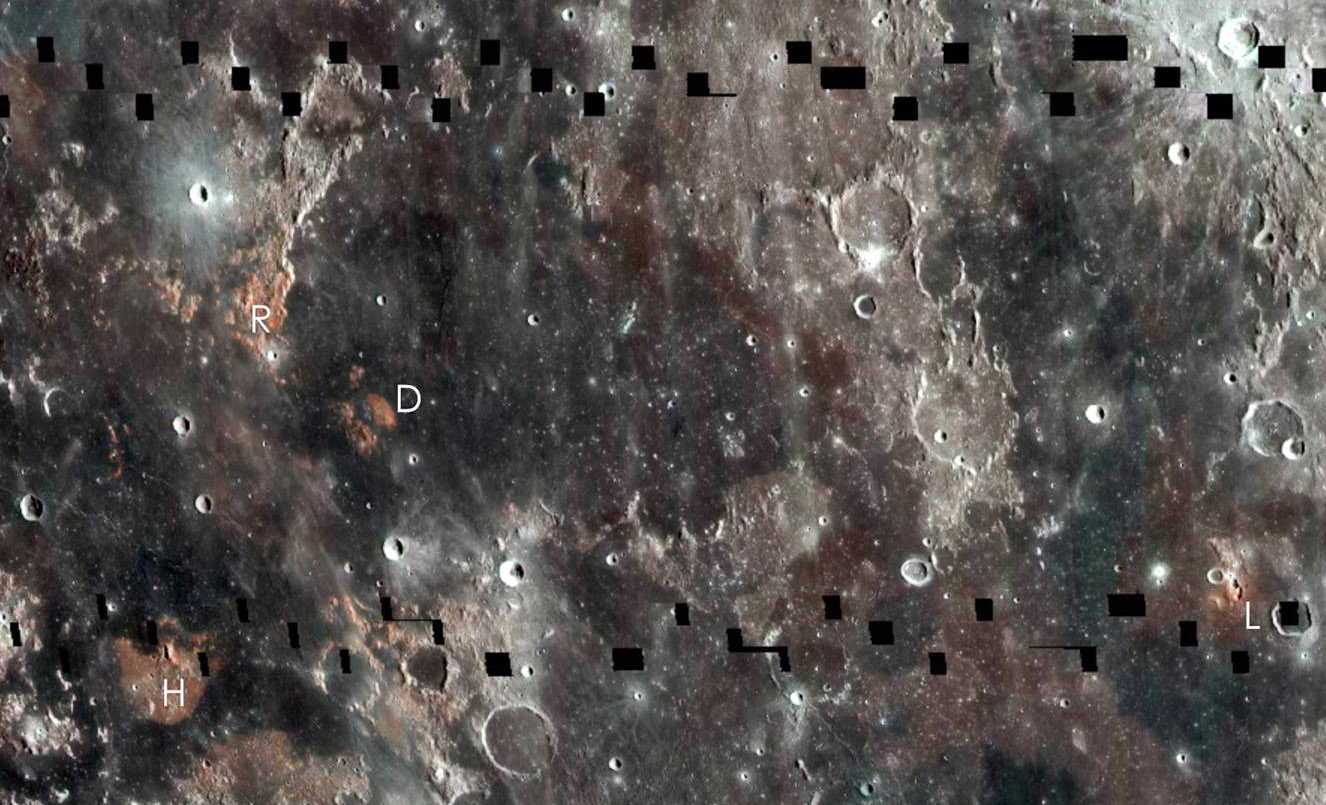Difference between revisions of "October 16, 2011"
| (2 intermediate revisions by the same user not shown) | |||
| Line 6: | Line 6: | ||
<em>image from [http://www.europlanet-eu.org/outreach/images/stories/ep/news/epsc2011/lroc_picture2.jpg NASA/GSFC/Arizona State University]. LRO WAC Color R 566nm, G 360nm, B 321 nm. Red SPots: R Riphaeus Mts, H Helmet, D Darney, L Lassell.</em><br /> | <em>image from [http://www.europlanet-eu.org/outreach/images/stories/ep/news/epsc2011/lroc_picture2.jpg NASA/GSFC/Arizona State University]. LRO WAC Color R 566nm, G 360nm, B 321 nm. Red SPots: R Riphaeus Mts, H Helmet, D Darney, L Lassell.</em><br /> | ||
<br /> | <br /> | ||
| − | In the late 1950s, when few scientists studied the Moon, Ewen Whitaker borrowed a technique from Fritz Zwicky, a galactic astronomer, | + | In the late 1950s, when few scientists studied the Moon, Ewen Whitaker borrowed a technique from Fritz Zwicky, a galactic astronomer, |
| − | to [http://articles.adsabs.harvard.edu/cgi-bin/nph-iarticle_query?1972Moon....4..348W&amp;data_type=PDF_HIGH&amp;whole_paper=YES&amp;type=PRINTER&amp;filetype=.pdf image] the Moon through red and blue filters. By combining these images in a way to eliminate albedo, Ewen was able to identify regions | + | to [http://articles.adsabs.harvard.edu/cgi-bin/nph-iarticle_query?1972Moon....4..348W&amp;data_type=PDF_HIGH&amp;whole_paper=YES&amp;type=PRINTER&amp;filetype=.pdf image] the Moon through red and blue filters. By combining these images in a way to eliminate albedo, Ewen was able to identify regions |
| − | of distinctly different colors, which we now know reflect different soil compositions. Jim Head and I studied Ewen's images and [http://articles.adsabs.harvard.edu/cgi-bin/nph-iarticle_query?1975LPICo.234..189W&amp;data_type=PDF_HIGH&amp;whole_paper=YES&amp;type=PRINTER&amp;filetype=.pdf described] | + | of distinctly different colors, which we now know reflect different soil compositions. Jim Head and I studied Ewen's images and [http://articles.adsabs.harvard.edu/cgi-bin/nph-iarticle_query?1975LPICo.234..189W&amp;data_type=PDF_HIGH&amp;whole_paper=YES&amp;type=PRINTER&amp;filetype=.pdf described] |
| − | a number of red spots that seemed like they might be volcanic rocks with compositions different than mare lavas. Now, color filtered images | + | a number of red spots that seemed like they might be volcanic rocks with compositions different than mare lavas. Now, color filtered images |
| − | with the Wide Angle Camera of the Lunar Reconnaissance Orbiter have updated Ewen's color contrast images with much higher resolution. | + | with the Wide Angle Camera of the Lunar Reconnaissance Orbiter have updated Ewen's color contrast images with much higher resolution. |
| − | Maria with medium to high titanium contents are blue, but what is interesting here are the very red, low titanium red spots labeled with letters. | + | Maria with medium to high titanium contents are blue, but what is interesting here are the very red, low titanium red spots labeled with letters. |
| − | Each represents a non-mare volcanic area, that we know, but what controls their distribution is still uncertain.<br /> | + | Each represents a non-mare volcanic area, that we know, but what controls their distribution is still uncertain. |
| + | <br /> | ||
<br /> | <br /> | ||
<em>[mailto:tychocrater@yahoo.com Chuck Wood]</em><br /> | <em>[mailto:tychocrater@yahoo.com Chuck Wood]</em><br /> | ||
<br /> | <br /> | ||
<strong>Related Links</strong><br /> | <strong>Related Links</strong><br /> | ||
| − | Rükl plate [ | + | Rükl plate [https://the-moon.us/wiki/R%C3%BCkl_42 42]<br /> |
<br /> | <br /> | ||
| + | <hr /> | ||
<p><b>Yesterday's LPOD:</b> [[October 15, 2011|Orangester]] </p> | <p><b>Yesterday's LPOD:</b> [[October 15, 2011|Orangester]] </p> | ||
<p><b>Tomorrow's LPOD:</b> [[October 17, 2011|FFC]] </p> | <p><b>Tomorrow's LPOD:</b> [[October 17, 2011|FFC]] </p> | ||
| − | < | + | <!-- End of content --> |
{{wiki/ArticleFooter}} | {{wiki/ArticleFooter}} | ||
Latest revision as of 18:55, 13 October 2018
Redder Spots

image from NASA/GSFC/Arizona State University. LRO WAC Color R 566nm, G 360nm, B 321 nm. Red SPots: R Riphaeus Mts, H Helmet, D Darney, L Lassell.
In the late 1950s, when few scientists studied the Moon, Ewen Whitaker borrowed a technique from Fritz Zwicky, a galactic astronomer,
to image the Moon through red and blue filters. By combining these images in a way to eliminate albedo, Ewen was able to identify regions
of distinctly different colors, which we now know reflect different soil compositions. Jim Head and I studied Ewen's images and described
a number of red spots that seemed like they might be volcanic rocks with compositions different than mare lavas. Now, color filtered images
with the Wide Angle Camera of the Lunar Reconnaissance Orbiter have updated Ewen's color contrast images with much higher resolution.
Maria with medium to high titanium contents are blue, but what is interesting here are the very red, low titanium red spots labeled with letters.
Each represents a non-mare volcanic area, that we know, but what controls their distribution is still uncertain.
Chuck Wood
Related Links
Rükl plate 42
Yesterday's LPOD: Orangester
Tomorrow's LPOD: FFC
COMMENTS?
Register, Log in, and join in the comments.



